Notícias de mercado & insights
Mantenha-se à frente dos mercados com insights de especialistas, notícias e análise técnica para orientar suas decisões de negociação.

Most traders understand EA portfolio balance through the lens of traditional risk management — controlling position sizes, diversifying currency pairs, or limiting exposure per trade.
But in automated trading, balance is about deliberately constructing a portfolio where different strategies complement each other, measuring their collective performance, and actively managing the mix based on those measurements.
The goal is to create a “book” of EAs that can help diversify performance over time, even when individual strategies hit rough patches.
A diversified mix of EAs across timeframes and assets can, in some cases, reduce reliance on any single strategy. This approach reduces dependency on any single EA’s performance, smooths your overall equity curve, and builds resilience across changing market conditions.
It’s about running the right mix, identifying gaps in your coverage, and viewing your automated trading operation as an integrated whole rather than a collection of independent systems.
Basic Evaluation Metrics – Your Start Point
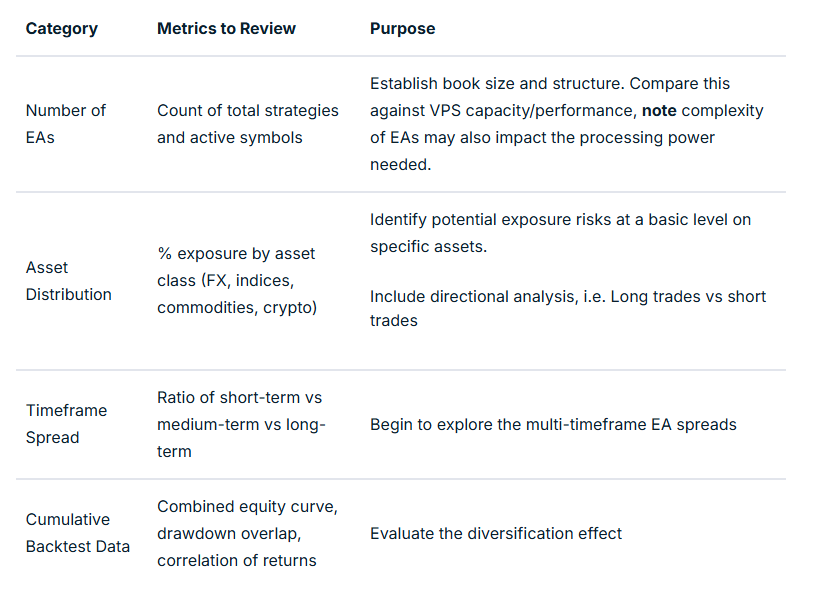
Temporal (timeframe) Balancing
When combined, a timeframe balance (even on the same model and instrument) can help flatten equity swings.
For example, a losing phase in a fast-acting M15 EA can often coincide with a profitable run in an H4 trend model.
Combining this with some market regime and sessional analysis can be beneficial.
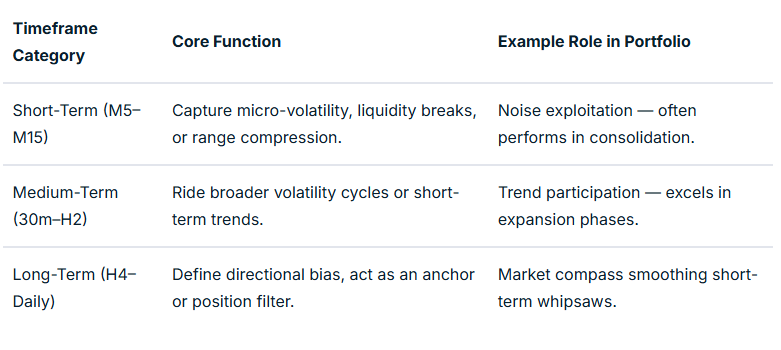
Asset Balance: Managing Systemic Correlation Risk
Running five different EAs on USDJPY might feel diversified if each uses different entry logic, even though they share the same systemic market driver.
But in an EA context, correlation measurement is not necessarily between prices, but between EA returns (equity changes) relating to specific strategies in specific market conditions.
Two EAs on the same symbol might use completely different logic and thus have near-zero correlation.
Conversely, two EAs on a different symbol may feel as though they should offer some balance, but if highly correlated in specific market conditions may not achieve your balancing aim.
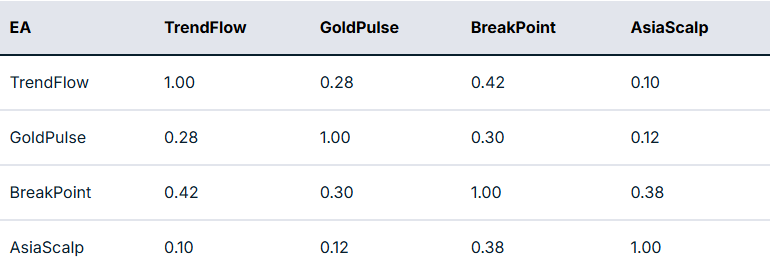
In practical terms, the next step is to take this measurement and map it to potential actionable interventions.
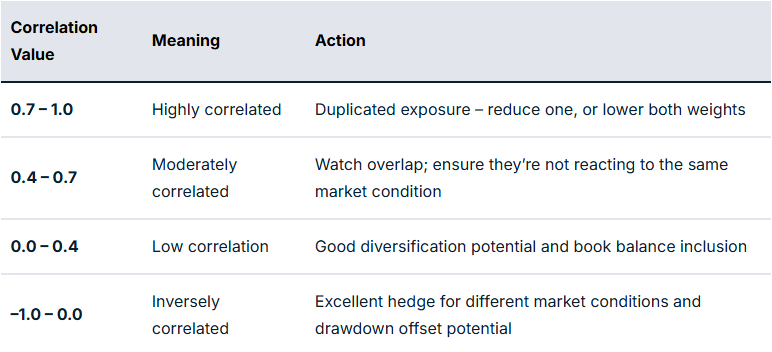
For example, if you have a EURUSD Trend EA and a GBPUSD Breakout EA with a correlation of 0.85, they are behaving like twins in performance related to specific market circumstances. And so you may want to limit exposure to some degree if you are finding that there are many relationships like this.
However, if your gold mean reversion EA correlates 0.25 compared to the rest of your book, this may offer some balance through reducing portfolio drawdown overlap.
Directional and Sentiment Balance
Markets are commonly described as risk-on or risk-off. This bias at any particular time is very likely to impact EA performance, dependent on how well balanced you are to deal with each scenario.
You may have heard the old market cliché of “up the staircase and down the elevator shaft” to describe how prices may move in alternative directions. It does appear that optimisation for each direction, rather than EAs that trade long and short, may offer better outcomes as two separate EAs rather than one catch-all.
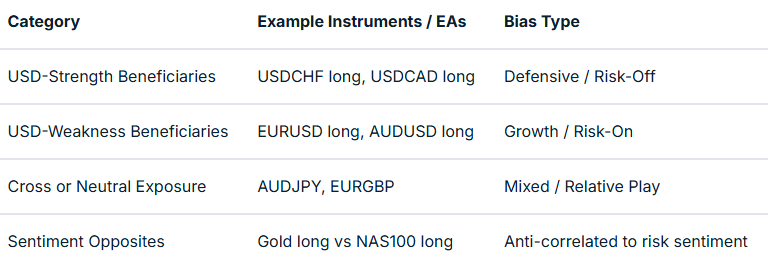
Market Regime and Volatility Balance
Trend and volatility states can have a profound impact on price action, whether as part of a discretionary or EA trading system. Much of this has a direct relationship to time of day, including the nature of individual sessions.
We have a market regime filter that incorporates trend and volatility factors in many EAs to account for this. This can be mapped and tested on a backtest and in a live environment to give evidence of strategy suitability for specific market conditions.
For example, mean reversion strategies may work well in the Asian session but less so in strongly trending markets and the higher volatility of the early part of the US session.
As part of balancing, you are asking questions as to whether you actually have EA strategies suited to different market regimes in place, or are you using these together to optimise book performance?
The table below summarises such an approach of regime vs market mapping:
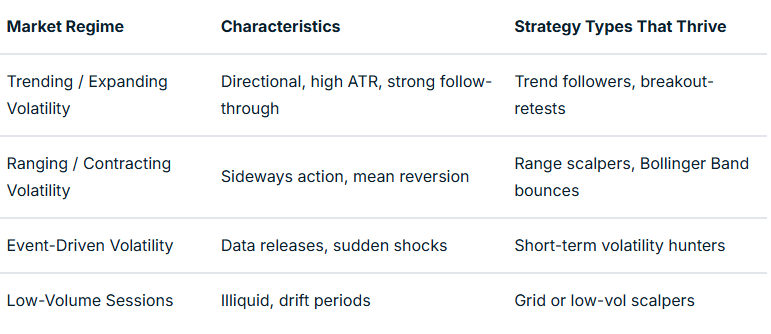
Multi-Level Analysis: From Composition to Interaction
Once your book is structured, the challenge is to turn it into something workable. An additional layer of refinement that turns theory and measurement into something meaningful in action is where any difference will be made.
This “closing the circle” is based on evidence and a true understanding of how your EAs are behaving together. It is the step that takes you to the point where automation can begin to move to the next level.
Mapping relationships with robust and detailed performance evaluation will take time to provide evidence that these are actually making a difference in meeting balancing aims.
To really excel, you should have systems in place that allow ongoing evaluation of the approaches you are using and advise of refinements that may improve things over time.
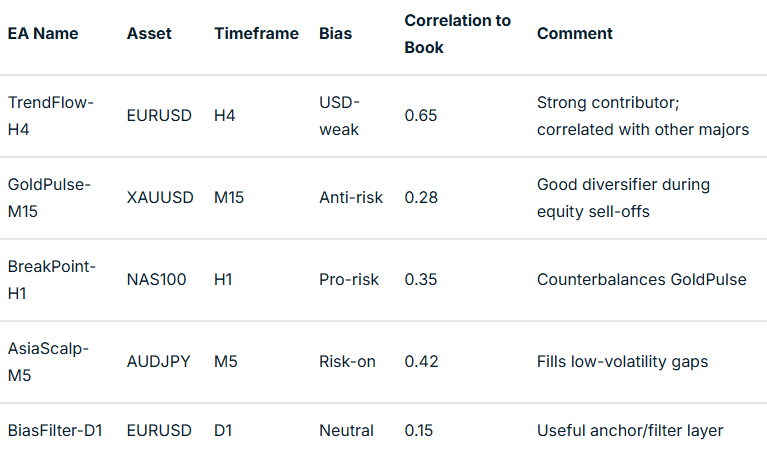
What Next? – Implementing Balance in Practice
Theory must ultimately translate into an executable EA book. A plan of action with landmarks to show progress and maintain motivation is crucial in this approach.
Defining classification tags, setting risk weights, and building monitoring dashboards are all worth consideration.
Advanced EA traders could also consider a supervisory ‘Sentinel’ EA, or ‘mothership’ approach, to enable or disable EAs dynamically based on underlying market metrics and external information integrated into EA coding decision-making.
Final Thoughts
A balanced EA portfolio is not generated by accident; it is well-thought-out, evidence-based and a continuously developing architecture. It is designed to offer improved risk management across your EA portfolio and improved trading outcomes.
Your process begins with mapping your existing strategies by number, asset, and timeframe, then expands into analysing correlations, directional bias, and volatility regimes.
When you reach the stage where one EA’s drawdown is another’s opportunity, you are no longer simply trading models but managing a system of EA systems. To finish, ask yourself the question, “Could this approach contribute to improved outcomes over time?”. If your answer is “yes,” then your mission is clear.
If you are interested in learning more about adding EAs to your trading toolbox, join the new GO EA Programme (coming soon) by contacting [email protected].


IntroductionMarcus stared at his computer in disbelief. The EUR/USD had just broken through what he'd convinced himself was a textbook “double bottom” formation. He has taken a larger position than his normal position, doubling his normal lot size on the back of a feeling of certainty that the pattern signalled a major reversal. Instead, the market moved downwards and then down some more. triggering his stop-loss and wiping out three weeks of gains.Despite the belief that the pattern was so clear, what he experienced was not unusual and will be a familiar story to many of us – it was simply his brain doing exactly what it has evolved to do, that is finding patterns, even when none existed (or even if they did there were ither reasons why an apparently textbook entry shouldn’t have been taken.In simple terms, our mind is naturally programmed to find patterns everywhere, it is how we have survived as a species and how we make sense of the sometimes-complex world around us. This has been the case ever since we have existed. Early hunters who quickly identified the subtle pattern of a predator moving within tall grass lived longer than those who dismissed such signals as random noiseWhen we look at trading charts, this same instinct kicks in, sometimes making us see meaningful patterns which, on more in-depth examination, could simply be random price movementsFields like behavioural finance and cognitive psychology have revolutionised our understanding of the interactions between financial markets and traders like you or me, demonstrating that traders often act in predictably irrational ways.Rather than being the perfectly rational participants in the market we would all like to always be, we are vulnerable to using numerous mental shortcuts and have so-called biases that can distort our perception of market action.At its foundation principles, behavioural finance recognises and explores why traders often make choices based on emotions, mental shortcuts, and social influences and explains why traders sometimes make decisions that go against their own best interests in the “heat” of the market action.This article aims to explore this concept in a little more detail and offer some practical suggestions as to how best to manage what may be at the basis of substantial risk to trading results.The Cognitive Science Behind Pattern RecognitionPattern recognition is our mind's ability to identify familiar structures or relationships in information. In trading, this means spotting formations in price charts (like "head and shoulders" or "double top" patterns as obvious examples) that we believe can predict future price movements.When analysing price movements across any tradable asset, when looking at price movements on a chart, on any timeframe, we automatically search for recognisable structures such as triangles, channels, support and resistance that might produce an expected move in a certain direction for a period subsequently.Some have suggested that this tendency relates to pareidolia, the same phenomenon that causes us to see faces in clouds or the famous "face on Mars." Our neural networks are primed to extract signal from noise, sometimes creating connections where none exist.So, in a trading context, so-called pareidolia might result in us seeing a "bullish pattern" in what's random market noise.Neuroscience research suggests that our brains use less energy when processing pattern information than when processing random data, so it is thought that this creates some sort of preference for pattern-based explanations, making us vulnerable to seeing market trends that may be questionable as indicatorsPattern Recognition and Cognitive BiasesA cognitive bias is simple terms, an error in thinking that may alter decisions and judgments, often at the point where we are about to act. These mental shortcuts help us process information quickly, but can commonly lead to serious mistakes in trading, where accuracy often matters more than speed.Many types of bias have been described, and many of you may have heard “Inner circle” \webinars in the past on this topic. The bottom-line result is invariably a move away from a written trading plan, and rarely does it result in favourable trading outcomes.For this article, let’s look at four common biases that are relevant to pattern recognition.
- Confirmation Bias
Confirmation bias is our tendency to more easily notice information that supports what we already believe, and inadvertently ignore information that may contradict our beliefs. In trading, this means paying attention to signals that confirm our market outlook while dismissing evidence that may suggest that perhaps what we are considering has a low probability of being successful.So, as an example, someone trading an oil futures CFD has an idea that the oil price could rally due to colder-than-expected weather conditions over the next few days. After entering a position, they might focus exclusively on weather reports predicting a continuation of cold levels, ignoring important data that suggested manufacturing activity (and so demand for energy) had come in lower than the market had expected. This “blindsiding” wasn’t because the information wasn't available, but because it had been filtered it out of the analysis relating to risks associated with taking such a position. This selective attention commonly happens undeliberately and requires a conscious effort to consider information, be it on a chart or news release, outside of what you are immediately focused on.
- Clustering Illusion
So-called “clustering illusion” happens when we mistake random events for meaningful patterns.In a trading context, this might be believing that certain days of the week consistently produce market movements in a particular direction, when a more rigorous investigation may suggest that the data doesn't support this conclusion.The clustering illusion involves perceiving meaningful patterns in genuinely random sequences. This bias manifests frequently in commodity and cryptocurrency markets, where volatility creates plenty of noise that can be mistaken for a technical signal that may be shaping up to be a change in sentiment.The danger with this is that even a handful of repeated similar price movements over a few trades may be convincing enough to suggest to the trader that he or she may be “onto something”.Commonly, when we are in this convinced state, we begin to take action regularly and have been so “duped” that this could be good and even excited about finding something potentially special, that it may take several losses, often heavy, before giving up on this as a trading idea.With further examination, it may have been identified that the previous "pattern" was merely coincidental clustering in an otherwise random sequence, obscured by our desire for pattern recognition and seeing some order in chaos.
- Narrative Fallacy
The narrative fallacy is our need to create stories that help us to explain why markets move the way they do. While these stories make us feel like we understand what's happening, they often oversimplify complex market dynamics and lead us astray.Humans look for stories that explain often complex phenomena, leading us to create narratives around what are fairly random or low probability price movements.Generally speaking, we may do this “plant our flag: thinking to explain what may be happening not only as it may feel satisfying but also because this often-misplaced understanding helps us to feel “in control” (and so in a better place to take action) rather than being at the mercy of frequent changes in sentiment.This preference for stories that make sense rather than more accurate ones based on more robust evidence can result in a succession of disappointing trade decisions.
- Recency Bias
Recency bias means giving too much importance to recent events when making decisions.In trading, there are a couple of ways that this is commonly demonstrated.Firstly, it often leads to chasing trends that have already peaked or have been underway for some time already, and we fear missing out on any further move in the same direction, only to see the price reverse soon after we enter.Another “symptom” can be that it may result in panicking after a few bad trades, even if your initial strategy has been robust, sound. The pattern of giving more back to the market may lead us to expect the same and exit a position too early when there is no actual technical evidence to do so.Recency bias can therefore often lead to late entry or early exit, both of which are likely to be detrimental to overall trading outcomes.The major solution is not only as with all cognitive biases to own that this is what you are doing, but, in this case, take a further look back on previous longer-term trading history, not just the last few trades, to help thatPractical Strategies to Manage Pattern BiasesFighting cognitive biases all starts with ownership of your trading behaviour. Too commonly, we look to place the blame for poorer results elsewhere, e.g. on markets, where the reason is internal within our distorted thinking at the point of taking trading action. requires creating systems that protect you from your thinking errors. Below are THREE practical approaches that any trader, regardless of experience level, can implement.
- Creating Trading Rules Before Seeing the Data
These are specific rules you write down BEFORE looking at today's market action. By deciding in advance what would make you buy or sell, you prevent your brain from "seeing" patterns that may not really be there.As well as specific, unambiguous written criteria in the form of a formal trading plan, we have talked before about the merits of a “daily agenda” where you re-align with a plan, look at key information resources relevant to the day, and standards of good trading practice. These will all help to put you in the optimum trading decision-making state and so less vulnerable to biases rearing their head during trading action.
- Maintaining a Trading Journal
A good trading journal records not just what trades you made, but why you made them and how you felt at the time. This helps you spot patterns in your behaviour that might be hurting your results.We have written before and presented examples of good practice on the potential effectiveness of journaling, including not just what was traded but why. This helps capture your trading mental state and pattern recognition process. Reviewing these notes regularly helps identify recurring psychological traps and, of course, is useful in the management of potential recency bias.
- Quantitative Validation Techniques
Moving onto a more advanced approach, this means using numbers and statistics, rather than gut feeling, to check if a pattern you think you see regularly really works.Moving beyond subjective chart interpretation, it is possible to develop more sophisticated ways to verify pattern validity.Even simple approaches can help such as tracking key metrics such as net profit, maximum drawdown, win rates and average gains/losses for specific patterns, across different strategies, trading direction and chosen markets vehicles can begin reveal which patterns are more likely to deserve your attention and of course those that should be ignored.Logically, if one accepts this, it may be worth creating code that allows some historical back-testing of your trading strategy ideas. This is possible even on the Metatrader platform strategy tester, even if your aim is not to go down an automated route in terms of confidence in the plan, it could be invaluable. Of course, increased confidence usually results in a decreased likelihood to stray from it and succumb to biases.In summaryOur pattern-seeking brains served us well not only in ancient times but do so in modern-day living, allowing us to function in a variety of complex situations. However, our inbuilt preference for seeing patterns when explored in the context of financial markets needs some awareness of potential risk and management.The line between skilled reading of sentiment and succumbing to potential cognitive bias can be very thin, with even experienced traders occasionally falling prey to false patterns that our mind convinces us may be there even if they are not.Through combining awareness of these psychological risks and putting the right things in place, traders can harness the strength of effective pattern recognition and timely action on a change in market sentiment, while minimising potential pitfalls.Your brain will naturally find patterns in market data – that is what brains do. Your responsibility as a trader is to recognise and manage this to be able to focus on what really works in your trading.


Introduction – Are Risk Management Rules Changing?Whether you’re trading FX, index CFDs, commodities, or stocks, today's market environment is arguably at its most risky, but also, of course, with increased risk, some would suggest comes increased opportunity.Whichever way you look at it, the most challenging time in attempting to have a positive trading outcome is when markets become increasingly headline-driven and with that increasingly volatile.Such markets demand decision-making which must be more rapid and flexible, as in minutes things can change with a planned news release that strays away from expectations, policy decisions made and then unmade within days or even hours adding to uncertainty, or a single unexpected social media post from those in power, can and often are sending markets surging or collapsing in a heartbeat.Old-school risk models that aim to protect capital and retain profit have always been an essential part of the trader’s toolbox. However, it could be suggested that these are built around more stable correlations, more gradual price shifts with at least some degree of certainty about what could happen in days or even weeks.With that traditional scenario appearing increasingly obsolete for right now, it merits questioning whether this is a market that traders who still rely on static stop distances, fixed-size positions, or set-and-forget strategies will thrive in. The reality is that they will often find themselves on the wrong side of violent whipsaw moves.Of course, it is worth emphasising that any risk management is far better than ad-hoc or, even worse, an absence of clear and unambiguous actions, irrespective of underlying market conditions. However, being able to achieve positive trading outcomes in all market conditions sometimes needs more than just having some rules in place and the discipline to follow them. It is often not just about being a smarter trader but about being the most adaptable.This article aims to offer some suggestions as to how to review what you are doing now with risks associated with capital protection, profit retention and missing opportunity.What could new market conditions mean for traditional risk management?Having given context for why exploring this in more detail, let’s examine the potential challenges that current market pressures may put upon more traditional risk management approaches that, as a reference, may not have been developed to be as effective as the trader may hope for.There are 3 factors that seem very relevant:
- Predictable market reactions to data, relatively stable spreads, and modest price swings are all based on some degree of certainty, with relatively speaking, little deviation, if you look at week-by-week changes in expectation beyond an occasional shift. Today, that world appears to be gone. We all know markets become uncomfortable in uncertain environments, You would only need look at the VIX index to see levels of uncertainty, not seen at such high levels recently since the early days of the COVID pandemic, Static stop placements that ignore volatility levels are increasingly ineffective, often triggering a trade closure unnecessarily in erratic price action.
It is clear that what is expected to happen next may all change tomorrow, and then again, the day after.
- Historical asset relationships, such as safe-haven flows into instruments such as the USD, have broken down when market discomfort becomes panic. Although some assets, such as the obvious example of gold, have flourished, arguably even this has had significant intraday movements. A breakdown of such relationships can not only impact on direct trading of such instruments but also the potential for effective exposure balancing.
- Sudden liquidity shocks that can occur around planned (and unplanned) news events are commonplace, it seems for right now, as is often the case in headline-driven markets. Price moves, either way, are often exaggerated as sentiment shifts rapidly and dramatically. Few traders want to be on top of the market and spend a whole day in front of a screen, but even being away for a few hours before checking in again can result in significant profits given back to the market without the ability to trail stops in a timely way. It is crucial that profit risks, i.e. giving back significant potential profit, are viewed with equal vigour as capital risk, i.e. a losing trade.
7 New Rules You Need to Know#1 Dynamic Position Sizing and Exposure Based on Volatility:Rather than applying a uniform lot size or number of contracts across all conditions, an adjustment in exposure, not only for individual trades but also across your account, would seem prudent.In high-volatility environments, typical of headline-driven markets, stop placement and position sizing should adjust:
- To account for wider ranges in price. Tools like ATR (Average True Range) or real-time implied volatility readings can be used to scale positions appropriately or move stops so that market noise is less likely to result in premature exit.
- To account for not only market conditions now but also the uncertainty created by potential new headlines. As previously referenced, the frequency of unplanned market-shifting news, outside of economic data release, is massively increased. Expecting the unexpected is always a massive challenge in practical terms, but approaches such as reduction of position sizing as well as reducing the number of positions open, e.g. if you have a maximum number of six positions as your norm, then considering reducing this to three positions may be worth contemplating as an approach.
#2 Scenario-Based Risk Planning:Perhaps current risk planning merits that traders think in possibilities, not certainties. For each trade, maybe traders should be asking the question, “What happens if this trading idea doesn’t work? “What happens if there is a significant change in tariff policy once the US wakes up?” Can I trust previous significant key price levels to hold?Planning responses for different outcomes can mean the difference between a controlled exit and a catastrophic loss.#3 Exposure Risk Awareness Over Single Trade Focus:It’s easy to focus risk management on a single trade. However, if you’re long AUDUSD and EURJPY, short the VIX, long copper futures CFD, and long mining stocks due to technical entries, your real exposure is heavily tied to a continuation of a “risk on” sentiment. If there is a sudden change in this sentiment, you potentially have portfolio exposure that could result in losses across five positions simultaneously.See your risk as this and perhaps not only, as suggested before, both setting a maximum number of trades but also being aware of “risk on” of ‘risk-off’ exposure.#4 Watch Stop Placement where others will be looking for them (and take advantage of this too!):Stop-losses placed at obvious technical levels (previous highs, lows, round numbers) are increasingly vulnerable in fast-moving markets. Experienced and institutional, as well as “stop hunters”, can and will exploit this, particularly in markets as they are now. Be extra vigilant to not only stay away from such levels, but also perhaps give a little more space away from them to account for increased volatility, potentially wider spreads and slippage.#5 Accessibility, Notifications, and Rapid Response:It is prudent that traders make sure they use the system tools that are available. These may include alerts on price levels, automated system trailing stops, as well as what you would normally use with stops and take profits.With pending orders, it may well be worth considering just giving a little more space to where you place orders to account for greater volatility, and perhaps it is worth giving up a few pips to be more certain of a price breakout, for example (as well as having time limits on these).Be aware that times such as these merit perhaps a few more frequent visits to your computer screen than may be your normal access. If this is not possible, then again, perhaps look at what and how you are trading, and not only be aware of the risks but temper your positions accordingly.#6 Flexibility in Strategy Selection:In hyper-volatile periods, not all strategies remain valid.Traditionally, in such times, breakout systems are thought to have a better chance of thriving (although false breakouts may be common – see above for pending order placement), while mean-reversion systems may often produce fewer desirable outcomes.However, there are often choppy periods of range-bound consolidation where, in reality, breakout strategies can suffer.Today's trader must constantly assess, sometimes multiple times during the trading day, whether the current market conditions align with their strategy style and if not, either adapt, step back from markets, or switch approach.Getting that overall big picture through looking at longer timeframes is arguably always important, but even more so in the current market state.#7 Psychological Capital Protection:It would be amiss to discuss these sorts of markets without referencing the potential psychological toll.Every trader has a breaking point where emotional control falters. Protecting financial capital has obviously been a major theme of this article, but protecting psychological capital, i.e. the ability to make rational decisions after a loss, is just as critical AND of course, the point at which you recognise that such a level has been reached.Establishing maximum daily or weekly loss limits, having mandatory time-outs after big losses (and arguably big wins too), and owning that you are straying from emotional discipline are all practical steps that can be taken.The risk is that market risk spirals, a failure to adjust and set such levels can be very damaging as the market sucks you in and poor decision take aver, don’t put yourself at risk destroy months of progress in a few days of undisciplined, emotionally driven trading.Conclusion: The REAL Trader’s Edge in a Volatile WorldIn a market state where we can see dramatic price shifts within seconds, rigid risk management approaches need to be reviewed.Flexibility, awareness, and using the system tools to have access to assist in monitoring and taking actions are not a luxury but arguably a necessity.Protecting your capital and reducing profit risk today isn't simply about setting a stop and a take profit, then hoping for the best; it’s about building dynamic, responsive systems that take into account increased uncertainty and volatility in headline-driven price moves.Making adjustments in your behaviour, your trading systems and of course keeping an eye on your own decisions are all paramount to not only survive but to give yourself to thrive in markets such as these.Many of the approaches referenced throughout this article are not particularly complex, most are very simple in fact.As always, you have choices to make.


It has been over 21 days since ‘Liberation Day’ – since then, the forest of chaos ensued as lead investors, traders, and the full gamut of financial participants lost sight of where we stand.Not surprising when you look at the reporting versus the market. The chaos has led to mass loss of confidence from both the consumer and business side, spending intentions have plummeted and ‘American Exceptionalism’ is ‘ending’ depending on your point of view – this is what’s being reported.The market, however, has had other ideas – since Liberation Day, most have gone a full 360-degree round trip and moreAUD/USD
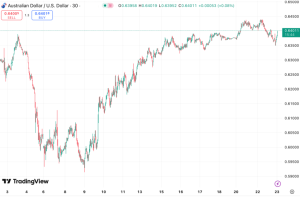
NZD/USD
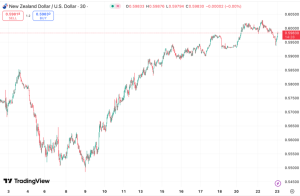
Equities, too, have done some staggering reversals of fortune. Outside of China and the US markets, most major indices are either at or near breakeven. We are talking about the likes of Canada, the UK, Australia, most of Europe, Japan, South Korea, Australia, New Zealand and take Mexico, one of the hardest hit nations in the new tariff order – it's up 6.4% since Liberation Day.So, can we see the forest from the trees? Or should that be the trees from the forest?We need to drill down to one player, and for that, we want to concentrate on Australia, as the chaos from Washington has clearly consumed everything and led to a loss of reality.So, where does Australia sit? Well, it entered 2025 with solid economic momentum. Fourth-quarter GDP figures surprised to the upside, inflation appeared to be bending back toward the RBA’s target band, and consumer sentiment was on the mend until Liberation Day. Domestically, the data painted a picture of a soft landing: one where inflation was moderating without significantly damaging the labour market or derailing growth. Happy days if you are running the RBA.And despite Liberation Day’s disruptions, Australia’s fundamentals overall remain largely intact.Capacity utilisation has begun to ease, labour markets are still tight, though the participation rate has slipped, and headline inflation pressures have eased thanks to falling import costs and policy-driven subsidies (which is not a good thing but has helped). Core inflation, too, is easing thanks to lower inputs from the likes of rents, household and personal services and financial services, but as yet has not cracked the RBA’s target band.Overall, the economy continues to expand, although modestly and forecasts for 2025 and 2026 have been downgraded as the outlook is becoming more finely balanced.One thing to keep in mind, too, is that Australia may even benefit from some aspects of the shifting global trade environment, particularly if supply chains are redirected away from the U.S., leading to cheaper goods and a further softening of import-driven inflation that Australia is heavily exposed to.A Deliberate Easing Cycle We background all this to give colour to an interesting trade development that has been lost in the chaos. RBA rate pricing.First things first – the consensus for the RBA cash rate is that by Christmas this year, the cash rate will fall to 3.1% - previous consensus was 3.6% - that’s a full 100 basis points (bps) out of the cash rate from this point in time.What significantly differs is the timing and size of cuts to reach the 3.1%.The RBA has already taken the first step with a February cut, which it framed “not as the beginning of a cycle but rather as a reversal of its precautionary hike in November 2023”.So, February was just a ‘righting’ of the ship. Where now? With inflation continuing to moderate and global uncertainty mounting, the case for additional easing is building—albeit cautiously.Inflation data supports this slower, data-dependent approach and having now seen and heard Michele Bullock in action for over 18 months, this is likely to be the most probable course of action.Real-time estimates for the first quarter trimmed-mean CPI due on the 30th of April sit at 0.6%, quarter-on-quarter and 2.8% for the year-on-year figure, which would mark the first time core inflation has been in the RBA’s target band since 2021.Housing inflation has continued to decelerate—likely a sustained trend through 2025—and extended electricity bill subsidies are expected to further soften headline numbers. At the current trajectory, consensus has inflation ending 2026 around 2.6%, firmly within the RBA’s target range. All positive news for an RBA cutting cycle.However, this is where the divergence is building – the inflation story is leading to a large front-loading of rate cuts. We know the RBA is prepared to act, but it remains wary of providing strong forward guidance. The minutes from the April meeting reaffirmed the Board’s concern over sticky unit labour costs—an issue exacerbated by weak productivity. Subsequent public remarks from the Governor and Deputy Governor stressed a cautious, reactive stance, as well as keeping some powder dry if the uncertainty leads to even larger issues. But a 50bps cut at the 20 May meeting looks to be an upside move.This will be interesting for the likes of the AUD, although it has rallied hard against the USD, like all other major currencies have. Against the likes of the EUR and GBP, it has clearly been priced on global risk, yes, but also the prospect of a large cut on 20 May.We caution this view. Why? The upcoming May 3 election has added another layer of complexity. Both major political parties have pledged significant increases in public spending across sectors such as healthcare, housing, aged care, and defence. The most recent pre-election Budget included modest tax cuts and extensions to electricity subsidies. The opposition has flagged further tax relief, including a potential cut to fuel excise as well as major support for home ownership through subsidies.These promises imply wider deficits and a rising debt load regardless of who forms the government. With no meaningful supply-side reforms on the table, Australia's fiscal trajectory is skewing looser.That ‘assistance’ is likely to stay the hand of the RBA from a shock cut for a more restrained 25bps cut. This is in keeping with the ‘narrow path’ it still uses for justification, balancing the need to support domestic sentiment and inflation targeting with caution around external volatility and fiscal expansion.Thus, we believe a more measured path is likely – this being 4 25bps cut meetings. Most likely being May, August, September and November. This is likely to see the AUD jumping from time to time due to overly bearish rate-cutting viewpoints.The forest is there – we just need to look in the right places and ignore the blowing breeze through the trees.


Why Is Gold in Focus Right Now?Throughout early 2025, gold has surged to record highs, breaching $3,400 an ounce for the first time in history. For newer traders, this may seem like a “blue-sky” breakout without precedent. For experienced market participants, it raises a more practical and important question, i.e. what is driving this rally, and is it sustainable?Understanding the fundamental and technical context behind such moves helps us not only trade the present but plan for what may come next, which can guide us in the decisions we make with our trading action.This article aims to build upon recent outlook webinars that we have delivered recently, which have waved the bullish flag throughout. However, I must admit to having been surprised at the velocity of the rally.We will try to unpick key drivers as well as analyse what could be next and why.What’s Driving the Gold Rally in 2025?Let’s take a look at the main contributing factors that are currently supporting the upward momentum in gold prices:1. Rising Global Uncertainty and Geopolitical RiskPolitical instability, as it has historically, remains a strong macro backdrop for gold. Recent flare-ups in geopolitical conflict — particularly in Eastern Europe and the Middle East — have returned “safe haven” flows back into focus. This is typical during periods when traditional risk assets like equities face greater downside volatility.Additionally, the somewhat turbulent start (even more so than many predicted) to the new U.S. administration has introduced an element of policy uncertainty, particularly around trade, inflation and the impact of economic growth. The possibility of further tariffs or fiscal tightening reinforces gold’s appeal as a form of protection.Key Point: Traders need to monitor not just existing conflicts, but also the market perception of risk. Gold often responds not to what is happening, but to what investors fear might happen.2. US V China – trade war brewing?Tariff dramas have been the major market chatter and sentiment changer over the last few weeks. On top of general broad international tariffs, and to pause or not to pause decisions, the major attention is, and likely to continue to be, the escalation of tariffs between the U.S. and China has pushed inflation expectations higher. While inflation has generally cooled since its 2022–2023 peaks, cost-push factors such as tariffs can reintroduce price pressures, particularly on imports.Central banks globally are including tariffs within a rate decision narrative, but no central bank is more in focus, of course, than the Federal Reserve. In Trump's last presidency, the current Fed chairman Jerome Powell came under fire for rate policy, and already, it was noteworthy that the current president aimed a shot at him once again. The market is aware that inflationary shocks are not off the table once tariff impact starts to bite at importer costs in the US, and the “priced in” rate cut that is likely to occur in June is still some time away, and the certainty that this may happen may start to waver. Gold has historically performed well when real yields (interest rates adjusted for inflation) fall or remain negative.Key Point: Watch CPI data closely. If inflation expectations start to climb again due to trade-related costs, gold may continue to benefit.3. U.S. Dollar WeaknessThe U.S. dollar index (DXY) has declined to multi-year lows, making gold more attractive to non-U.S. investors. This is a classic inverse relationship — as the dollar falls, gold often rises.A weaker dollar could potentially indicating that the market could be pricing in a more dovish Federal Reserve, with rate cuts potentially on the table later in the year, However, more likely in this case, the dramatic drop in the USD, which this week hit 3 year lows, is more likely due to concerns about growth and even the perceived chance of recession.At the time of writing, the earnings season is ramping up, and despite Q1 results so far being relatively positive, we are already seeing concerns expressed (as is often the case with uncertainty) relating to forward guidance. This, of course, plays into the slowdown narrative. This week's PMI data feels as though it may have even more importance than usual.Key Point: Gold traders should always include USD direction in their macro framework. It often amplifies or suppresses broader trends in the metal.4. Central Bank and Institutional DemandAnother major support for gold is the persistent demand from central banks, particularly in emerging markets such as China and Turkey. These institutions are increasingly shifting reserves into gold as part of long-term diversification away from USD assets.Evidence suggests ETF flows have also picked up, showing increasing but not outrageous levels, suggesting the move is still institutional in nature rather than purely speculative.Key Point: As long as institutional and central bank demand remains steady or rising, gold has a structural reason to be supported underneath current price levels.What the Technical Picture Is Telling UsWhile fundamental drivers continue to support gold, the technical setup also tells an important story — one that can help traders decide whether to stay in, take partial profits, or prepare for tactical re-entries after any price pullback. Let’s explore the technical picture in a bit more detail.
- Gold’s Long-Term Trend Structure Remains Intact
Gold has been making a consistent series of higher highs and higher lows since mid-2023. This trend has been confirmed across multiple timeframes, including the daily and weekly charts — an important feature for position traders.Currently, price is well above both the 50-day and 200-day exponential moving averages (EMA), which have now turned upward and widened — a classic sign of trend strength and directional bias. When prices pull back in strong trends, these EMAs often serve as dynamic support levels.
- Momentum: The weekly RSI is elevated (above 75), which suggests gold may be in overbought territory in the short term.
What About RSI Being Overbought?One of the most common misunderstandings among newer traders is how to interpret an elevated RSI (Relative Strength Index), particularly when it crosses above the traditional 70 level.RSI above 70 does not automatically mean 'sell' — especially in strong trends, so this merits a little further discussion.Here’s why a high RSI may not be a problem:
- Context matters: In trending markets, RSI can remain elevated (above 70 or even 80) for extended periods without any meaningful pullback. This is often referred to as a 'momentum breakout' condition.
- Confirmation from volume: If rising RSI is accompanied by increased volume, it suggests that momentum is being supported by participation, not exhaustion. Currently, weekly volume has expanded on breakout weeks, supporting the move.
- New highs with RSI > 70 are actually bullish: A strong market making new highs and registering overbought readings usually reflects strength, not vulnerability — unless divergence begins to appear.
Key Point: Use RSI as a momentum gauge, not a reversal trigger in isolation. In this case, RSI supports the idea that gold is strong, not yet stretched to the point of reversal.
- Next Targets: Many technical analysts are watching $3,500 and $3,650 as key psychological and Fibonacci extension levels. A sustained break above $3,400 would likely bring these into view.
- Support Levels: If price retraces, $3,200 and $3,050 are likely areas where buyers may step back in, especially if the macro story remains intact.Key Point: Momentum remains strong, but even in trending markets, corrections are normal. Having a plan for where to re-engage is just as important as knowing when to stay out.
- What Would a Healthy Pullback Look Like?
Even the strongest trends pause. If gold does retrace in the short term, the nature of the pullback is more important than whether it happens.Signs of a healthy pullback include:- Controlled decline in decreasing volume- Price respecting prior breakout zones — e.g., $3,250–$3,280- Holding dynamic support like the 20-day or 50-day EMA- Reversal candle patterns near support (e.g., hammer, bullish engulfing)Key Point: In strong markets, pullbacks are often shallow and short-lived. They can be opportunities to scale in, provided the structure remains intact.Sentiment and Positioning: Are Traders Too Bullish?It’s important not to get swept up in price action alone. The COT (Commitments of Traders) report can provide valuable insight into whether markets are approaching overly crowded levels.
- Large Speculators have increased their net long positions, but not yet at levels seen in major historical peaks.
- Retail traders have only recently started to increase exposure, which suggests the move is not fully mature.
- ETF inflows, while rising, are still below the aggressive flows seen in 2020.Key Point: Current positioning suggests there may still be room to run, especially if new catalysts emerge. However, if positioning becomes too lopsided, be ready for faster and sharper corrections.
What Could Change the Narrative….Risks to Watch?Even with a strong bull case, traders must stay aware of what could derail gold’s momentum:Risk Event #1: Sudden USD reboundImpact on Gold: Could trigger a sharp pullbackRisk Event #2: Hawkish Fed surpriseImpact on Gold: Logically higher real yields = bearish gold due to USD impact – however, gold’s role as an inflation risk is likely to offset this.Risk Event #3: De-escalation of trade/geopolitical tensionsImpact on Gold: Safe-haven demand may soften if this is part of the reason for the current price rise. However, with other factors predominating price moves for right now, again, this may not be critical.Risk Event #4: Profit-taking and reversal in momentumImpact on Gold: Could create a short-term topKey Point: Risk doesn’t always mean reversal — but it does mean adjusting trade size, stops, and expectations when conditions change.Summary: Stay Informed, Stay DisciplinedGold’s rise in 2025 has been impressive, but it hasn’t been irrational. The macro backdrop, institutional support, and technical structure all support the trend.However, markets rarely move in straight lines, and traders should stay ready for both continuation and correction scenarios.Success is likely to lie in applying consistency in the management of profit and capital risks, as well as having a clear method to re-enter as appropriate. consistently while remaining adaptable to changing conditions.Traders should view the current gold move as a reflection of persistent macro themes and technical support rather than any sort of “bubble”. Whether you’re already long or waiting for a retracement, your decision-making should be rooted in having a clear and unambiguous trading plan and, of course, the discipline of follow-through in the actions you take.


Why have a Trading Plan? We all know that markets can be chaotic, unpredictable, and emotionally wearing when you are trading. Without a structured approach, even experienced traders can find themselves making impulsive and often poor decisions, both on entry and exit, that lead to significant losses and cap any potential profit.A trading plan serves as your personal roadmap for trading financial markets—a set of rules and guidelines that dictate your trading behaviour in varied market conditions irrespective of which instruments or timeframes you are trading. Think of your trading plan as the foundation of your trading business. It can provide clarity, consistency in action, and the basis for improvement in outcomes (through measurement and refining). These are all crucial for long-term success in trading.This article aims to address some of the key principles of trading plan development and usage. For those less experienced, use it as guidance to get you started. For those of you who are a little further down your trading journey, here is a refresher and checklist to make sure you have what you need in place.Common Mistakes Traders Make (And How to Avoid Them)Mistake #1: Trading Without a PlanProblem: Many traders enter the market with nothing but hope and excitement, treating trading more like gambling than a strategic business venture.Solution: Commit to never placing a trade that is not consistent with your written plan on entry AND exit. Even a simple plan is better than none at all. Start with basic rules about entry criteria, position sizing, and risk management and then add to it from there.Mistake #2: Creating an Overly Complex PlanProblem: Some traders create plans so intricate that they become impractical to follow in real-time trading conditions in the heat of the market.Solution: Your plan should be comprehensive enough to cover all scenarios but simple enough that you can make decisions and take action on key points under pressure. You should only use indicators on your plan that you understand, i.e. what they are telling you about the chart you are looking at. Mistake #3: Failing to Define Risk GuidelinesProblem: Without clear risk guidelines, traders often take positions that are too large relative to their account size. Failing to recognise this may lead to catastrophic losses or giving back significant profit from trades that go in your direction.Solution: Establish strict risk-per-trade rules, e.g. x% of account size (many professionals never risk more than 1-2% of their capital on a single trade). Define maximum drawdown levels that would trigger a trading pause or strategy review.Mistake #4: Not Adapting to Changing Market ConditionsProblem: Market conditions constantly change, and a strategy that worked last year might not work today.Solution: As part of your performance evaluation, it would seem logical to include a reference to a market type, e.g., bullish, bearish, choppy, or volatile. Through recording this, it may be possible to recognise which markets are the best fit for a specific strategy (and, of course, those that are not).Mistake #5: Ignoring the Psychological Aspects of TradingProblem: Trading psychology often determines success more than technical knowledge, yet many plans focus exclusively on entry and exit rules.Solution: Incorporate psychological safeguards into your plan. Identify your emotional triggers and articulate in your plan some rules for when you should and shouldn't trade, e.g. when unwell or having a succession of losses. It is always good practice to take a break from trading intermittently.Step-by-Step Guide to Creating Your Trading PlanStep 1: Select Your Markets and TimeframesNot all markets or timeframes will suit your personal circumstances or risk profile, so defining:
- Which markets match your interests, knowledge, and available trading hours?
- Will you be a day trader, swing trader, or longer-term position trader?
- What specific timeframes will you focus on for analysis and execution?
Many successful traders may ultimately specialise in specific sectors or instruments where they've developed an understanding of what creates price movement and what may happen next, rather than trying to trade everything. This will obviously take time but is worth some consideration if you find you are excelling in certain conditions. Step 2: Develop Your Trading Strategy This is the core of your plan, describing exactly how you'll identify and execute trades:Market Analysis Methods:What you use to help make trading decisions is at the basis of any strategy. There are a number of tools you can use, such as technical indicators (e.g. moving averages, RSI, MACD, etc.) and chart patterns you'll look for (head and shoulders, double tops, flag patterns). Fundamental factors you'll consider (earnings reports, economic data releases, sector trends) are all classic examples.Entry Rules:These are specific conditions that must be met before entering a trade. These MUST be unambiguous and objective, often a set of criteria statements that cover EVERY element of your trading decision making.
- This will often consist of statements about price action, candle structure and patterns used. Additionally, a series of confirmation signals that are usually required will be outlined (e.g., volume confirmation above a longer-term moving average) as well as a news event filter (whether you'll trade around major announcements) and perhaps the time of day.
Each of these requires a separate statement. Exit Rules:
- Profit target methods (fixed points, e.g. X ATR multiple, technical levels, e.g. next resistance if in a long trade, and the use of trailing stops)
- Stop-loss placement strategy (volatility-based, e.g. X ATR below entry, support/resistance based)
- Partial profit-taking rules (scaling out at specific targets)
Be exceedingly specific in your strategy. For example:
- Enter long when price closes above the neckline following a reverse head and shoulders
- Price is over the 50-day EMA
- RSI is between 40-60 (indicating potential momentum shift)
- Volume is increasing from the previous bar
- Place stop-loss at the most recent swing low
- Trail a stop using the 20EMA
- Your strategy should also address different market conditions. A strategy that works in a trending market may fail in a ranging market. Consider creating decision trees for various scenarios you might encounter.
Step 3: Establish Risk and Money Management RulesThis section protects your trading capital and is arguably the most critical part of your plan:
- Maximum risk per trade (ideally 0.5-2% of total capital)
- Position sizing formula based on stop distance (e.g., Risk Amount of account capital ÷ Stop Distance = Position Size). At an advanced level, you could look to tie this to an objective strength of signal measure and adjust accordingly.
- Maximum correlated exposure (e.g., no more than 2 trades of FX pairs when one of these includes USD)
- Maximum account drawdown before taking a break (e.g., 10% drawdown triggers a trading pause)
These rules should be non-negotiable and followed rigorously, regardless of how confident you feel about a trade.Step 4: Create Your Trading Routine There is no doubt that consistency breeds success in trading:
- Pre-market routine (what analysis you'll do before trading)
- During market hours (how you'll monitor positions, what would trigger new entries)
- Post-market review (how you'll record and analyse your trading day)
- Weekly and monthly review processes
A structured routine eliminates many decision points that could otherwise lead to impulsive actions.Step 5: Plan for Continuous ImprovementYour growth as a trader SHOULD never stop (although many traders fail to progress). make sure that you have a system in place for making sure you DO :
- How and when you'll review your trading performance
- Metrics you'll track to evaluate success, e.g. Net profit, drawdown, win rate, average win/loss
- Education resources you'll use to improve
- Benchmarks for advancing to larger position sizes or new strategies
Step 6: Document EverythingCompile all the above elements into a written document and, of course, have a trading journal to assist in the evaluation of performance.Within this, don’t forget to include some reference to how you are feeling, what you need to work on and what learning could be next for you.Step 7: Putting Your Plan into Action Having a plan is only the first step—consistently following it is what separates successful traders from the rest. Here are some tips for adherence:
- Keep it visible: Post a summary of your trading rules where you can see them while trading.
- Use checklists: Create pre-trade checklists to ensure you're following your plan for each trade.
- Automate where possible: Use technology to enforce discipline (preset stop-losses, position sizing calculators).
- Accountability partners: Consider sharing your plan with a trusted trading friend who can help keep you accountable.
- Reward compliance: Develop a system to reward yourself for following your plan, regardless of the trading outcome.
Remember, the success of a trade is not measured by profit or loss but by how well you adhered to your plan. A losing trade that followed your rules is actually a success from a process perspective, and adhering to your plan despite singular losses is more likely to result in better outcomes over a succession of trades.Conclusion A well-crafted trading plan transforms trading from a stress-inducing gamble into a structured business operation. While markets will always contain an element of unpredictability, your response to them doesn't have to be unpredictable.Take the time to develop a comprehensive plan that reflects your goals, resources, and personality. Then commit to following it with discipline. In the words of legendary trader Paul Tudor Jones, "Don't focus on making money; focus on protecting what you have." A good trading plan does exactly that—it protects you from yourself and the market's inevitable uncertainties.Your trading plan is a living document that will evolve as you grow as a trader. The process of creating and refining it is itself a valuable exercise that will deepen your understanding of the markets and your relationship with them.


Global markets continue to search for anything they can grasp onto that points to possible signs of progress on global trade tensions, and by anything, we do mean ‘anything’ – truth social posts, X posts, this person heard from this person something tangible. It shows just how volatile this current market really is that inuendo and whim is being treated as fact.Back in the ‘tangible’ real world, the other white knight that is being watched ever closely is some form of possible policy backstop from central banks - Particularly the Federal Reserve. Considering the President’s consistent input here that US rates should be lower either through a post or a media rant, so far this has not moved the Fed one inch.While the recent 90-day tariff pause from Liberation Day has provided a temporary market reprieve, the underlying trade tensions, especially between the U.S. and China, remain largely unresolved. In fact, we would argue they are only getting stronger as nations and blocs are now looking to each other to offset the US trade impasse.China remains the most consequential player in this landscape, and despite the pause, the effective U.S. (weighted-average) tariff rate on goods has only fallen modestly, just 3%, from a 24% peak to 21% year-to-date.Beijing appears to be holding the ‘better hand’ currently; the additional back down from Washington with its ‘exemption’ on electronics is case in point. Just take Apple as the example, down over 23% since its peak in December last year, and it is the poster child for the full impact of Trump’s program. This back-down is showing just how much strain the US is experiencing with Beijing playing hardball.Think about it: a US$3,000 iPhone versus a Samsung that, even with tariffs, could be as much as 20% less for the US consumers. That’s a killer for the Silicon Valley Titan and Trump’s plan on the whole.This just shows the structural nature of the U.S.-China trade imbalance and the scale of bilateral tariffs already in place.As negotiations remain tentative and tensions persist, the market is left navigating a landscape shaped by potential escalation, geopolitical signalling, and the lingering question of whether or even what policymakers will/can do if economic or market stress intensifies.China: Market KingmakerAs mentioned, the modest drop in the effective tariff rate even after a 90-day pause highlights the entrenched nature of the dispute. The sheer scale of U.S.-China trade means that even minor changes have significant global implications. While no breakthrough appears imminent, traders and investors alike continue to watch for any sign of constructive engagement – which currently does not exist, if we are honest.Any sign of negotiation could take place, or even if there is a modest de-escalation, it could trigger a risk-on response across asset classes as seen in the final part of the week beginning 7 March 2025. This is why China is now the market kingmaker – it is currently holding firm on ‘escalating’ when responding to Washington’s moves.The indicator we all need to watch for around US/China relations is US Treasury Bonds. Any sign that Beijing is turning from escalation to de-escalation should produce a rally sharply here as market flows have been dominated by heightened cash preference as persistent stagflation concerns, coupled with recession risks.Where’s the Fed at?Will the Federal Reserve step in to support markets? The better question is, can it step in? From a traditional standpoint with rate cuts – no. However, there are other mechanisms like exemptions to the Supplementary Leverage Ratio (this is the amount of tier one capital required to be held at US banks), which was temporarily introduced during the 2020 pandemic crisis. A repeat of that policy would increase the banking system’s capacity to absorb government bonds without triggering capital constraints.More aggressive tools, such as direct purchases at the long end of the U.S. yield curve, are considered much less likely in the current macro environment, and Fed officials have been cautious in their recent commentary around this idea.Realistically, there are limited signs of funding stress and a relatively high threshold for intervention; the probability of a "Fed put" being activated near-term appears low to non-existent. This means the Fed is just as much a spectator as we are.The FX flowWith US exceptionalism now on the blink, the broader trend of US dollar weakness is expected to persist, but the weak spots may change.Rather than concentrating on current account surplus currencies such as JPY and CHF, the weakness may broaden out to risk-sensitive FX like AUD, NZD, and CAD. Just take a look at the bounce back in AUDUSD at the backend of the 7 March week’s trading – a 3.8% jump in 2 days is unheard of.The euro is expected to perform well across both “risk-on” and “risk-off” tariff scenarios, driven by long-term capital reallocation and structural factors within the euro area.We need to highlight Japan and South Korea – both nations have shown signs they are willing to engage with Washington, and the response from the market was huge. More importantly, the administration has responded positively. This puts JPY and KRW in a more positive light than peers, and they would be wary of being exposed as a deal would put them into upside air very quickly.Outlook: Cloudy but clearing – chance of tariff showers later in the week.Markets remain in a holding pattern, waiting for clearer signals on trade policy.The recent softening of rhetoric from the U.S., particularly in response to financial market volatility, suggests some room for constructive negotiations—especially with countries outside China.The 90-day pause has provided some breathing space, but it will need to be followed by tangible progress if market sentiment is to turn, and on that metric, the outlook is still cloudy but clearing. Yet tariff risks retain high later in the period as the 90-day period looks to expire and specific tariffs (healthcare, electronics, etc) get announced.

